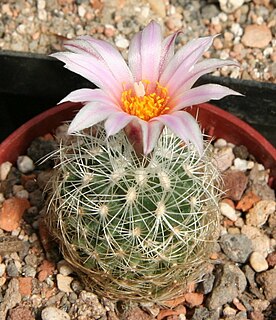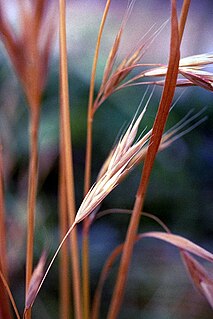
Echis carinatus is a venomous viper species found in parts of the Middle East and Central Asia, and especially the Indian subcontinent. It is the smallest member of the big four snakes that are responsible for causing the most snakebite cases and deaths, due to various factors including their frequent occurrence in highly populated regions, and their inconspicuous nature. Five subspecies are currently recognized, including the nominate subspecies described here.

Turbinicarpus is a genus of very small to medium-sized cacti, which inhabit the north-eastern regions of Mexico, in particular the states of San Luis Potosí, Guanajuato, Nuevo León, Querétaro, Hidalgo, Coahuila, Tamaulipas and Zacatecas.
Gryponyx is an extinct genus of massopod sauropodomorph known from southern Free State, central South Africa.

Plateosauridae is a family of plateosaurian sauropodomorphs from the Late Triassic of Europe, Africa and Asia. Although several dinosaurs have been classified as plateosaurids over the years, the family Plateosauridae is now restricted to Plateosaurus. In another study, Yates (2003) sunk Sellosaurus into Plateosaurus.

The razor-backed musk turtle is a species of turtle in the family Kinosternidae. The species is native to the southern United States. There are no subspecies that are recognized as being valid.

Leiocephalus carinatus, commonly known as the northern curly-tailed lizard, is a species of lizard in the family Leiocephalidae.

Bromus carinatus is a species of brome grass known by the common names California brome and mountain brome.

Macrochelidae is a family of mites in the order Mesostigmata, containing the following genera and species:

Macrocheles is a genus of mites in the family Macrochelidae. There are more than 100 described species in Macrocheles.
Macrocheles lukoschusi is a species of mite in the family Macrochelidae.
Macrocheles merdarius is a species of mite in the family Macrochelidae. It is found in New Zealand and Europe.
Macrocheles muscaedomesticae is a species of mite in the family Macrochelidae. It is found in New Zealand and Europe.
Macrocheles opacus is a species of mite in the family Macrochelidae.
Macrocheles peniculatus is a species of mite in the family Macrochelidae.
Macrocheles perglaber is a species of mite in the family Macrochelidae. It is found in New Zealand.
Macrocheles roquensis is a species of mite in the family Macrochelidae.
Macrocheles subbadius is a species of mite in the family Macrochelidae. It is found in New Zealand and Europe.
Macrocheles subcoenosus is a species of mite in the family Macrochelidae.
The comb-spined catfish is a species of catfish in the family Ariidae. It was described by Max Carl Wilhelm Weber in 1913, originally under the genus Arius. It is known to inhabit freshwater rivers in New Guinea. It reaches a standard length of 40 cm (16 in). Its diet includes prawns, detritus, and a variety of terrestrial and aquatic insects and insect larvae.

Ngwevu is a genus of massospondylid sauropodomorph dinosaur from the Lower Jurassic Elliot Formation of South Africa. The type and only known specimen, BP/1/4779, was discovered in 1978 by James William Kitching. It had in 1990 and 2004 been regarded as an unusual specimen of the related Massospondylus, with a horizontally and vertically compressed skull, but in 2019 the specimen was after restudy concluded to belong to a new distinct genus. The genus is primarily distinguished by its skull being more robust than that of Massospondylus.








